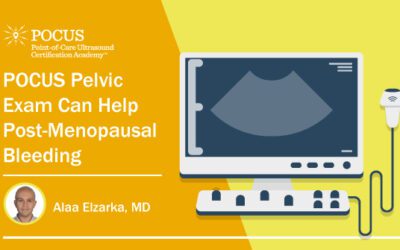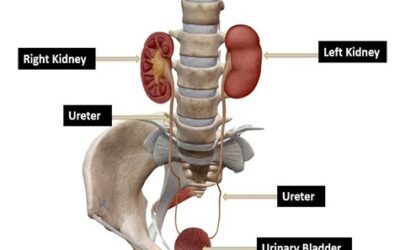Many patients brought to the Emergency department (ED) require an immediate diagnosis of acute conditions requiring time-critical investigation and management, which often makes the difference between life and death. Point-of-care ultrasound (POCUS) improves the speed and accuracy of diagnosis in certain critical cases.
POCUS is effective and efficient as a diagnostic tool in the ED for detecting the following acute conditions:
- Cardiac tamponade
- Pneumothorax
- Hemothorax
- Fractures of long bones
- Tendon injuries
- Hip pain
- Traumatic injury
- Occult bleeding – post-traumatic
Extended Focused Assessment with Sonography for Trauma (E-FAST) scan is a POCUS examination used by emergency physicians to identify fluid in the peritoneal, pericardial, or pleural spaces, including pneumothorax. When time is of the essence in treating unstable patients, an E-FAST exam can be performed with speed simultaneously with resuscitation. Conditions with similar symptoms can be ruled out, allowing the clinician to quickly zero in on the diagnosis.
Cardiac Arrest
Cardiac tamponade and pulmonary embolism (PE) are potentially reversible causes of cardiac arrest if identified quickly and treated properly. The SESAME-protocol can be applied and used during CPR without disrupting resuscitation. POCUS is instrumental in detecting the absence of cardiac activity and guiding decision-making on continuing with CPR or initiating other forms of treatments.
Lung Ultrasound
A POCUS scan on patients admitted with respiratory failure can be performed in less than three minutes. The ultrasound provides valuable information, such as detecting pathological lung conditions that result in the lungs filling with pus or the pleural space filling with fluid or blood. For example, the Bedside Lung Ultrasound in Emergency (BLUE) protocol helps diagnose some common respiratory conditions. Studies have shown that POCUS significantly reduces diagnostic time and outperforms chest X-ray and auscultation exams.
Fractures
Non-displaced fractures can be challenging to identify on radiographs. The highly vascular nature of the bone can cause the subperiosteal fluid to be seen with ultrasound when it is fractured. Diaphyseal fracture is a common orthopedic injury, but if treated inadequately, it can result in significant loss of function to the hand or arm. Any cortical disruptions or irregularities can be seen easily with ultrasound imaging. No fluid or cortical breaches may rule out a fracture in long bones.
Tendons
Tendon injuries are typically diagnosed by history and clinical examination. However, despite a thorough clinical examination, some tendon injuries can be missed in the initial hyperacute phase. POCUS is ideal for identifying tendon trauma as most tendons are located closer to the surface of the body. Due to the immediacy of POCUS diagnosis capability, delayed treatment resulting in impaired repair can be avoided.
Hip Pain
When a patient comes to the emergency room with acute hip pain, the underlying cause can be septic arthritis or a traumatic effusion. Septic arthritis must be identified as soon as possible. If left untreated, it can destroy the joint or even cause death.
Ultrasound is considered the best modality to identify hip effusions by detecting fluid collection. The ED can speed diagnosis and treatment using POCUS. According to an article in PubMed Central (PMC), trained POCUS physicians can identify hip effusions in the pediatric population with a sensitivity of 85 % and specificity of 100%.
Traumatic Injury
In the hospital setting, the radiology department is often located in a different wing or on another floor, creating a significant distance between it and the ED. There may not be enough time to transfer a patient for scanning in traumatic injury cases such as gunshots, knife wounds, and car accident injuries. Sometimes, the patient may be hemodynamically unstable to be transferred to the radiology department. Emergency medicine physicians can use POCUS to immediately detect internal bleeding or cardiac tamponade, which can make a difference in saving a life.
Higher Quality of Care
POCUS in the ED increases patient satisfaction and gives them a better perception of the facility. The speed and diagnosis accuracy with POCUS results in prompt and accurate treatment and can prevent unnecessary or prolonged hospital stays or even fatal outcomes.
Conclusion
POCUS has transformed emergency medical services, allowing physicians and paramedics to enhance the accuracy of their diagnosis in a pre-hospital setting. This pocket-sized modality has become an emergency care partner to healthcare professionals tending to patients in critical condition.
POCUS can improve patient outcomes and experience. Trained and certified emergency care providers will increase positive results and patients’ confidence. Physicians who understand the application of POCUS, its strengths, and limitations will find it invaluable as a tool to improve diagnostics and, therefore, patient care.
The Point-of-Care Ultrasound (POCUS) Certification Academy™ has certifications that are easily accessible for all emergency care providers. The Emergency Medicine Certification is an online program developed to validate the clinical proficiency of a POCUS provider treating patients within an emergency setting. Affirmation of expertise, knowledge, and skill sets focuses on seven specialty areas.
With this option and more, access to training is no longer a barrier to the use of POCUS in emergency care, the ICU, or critical care departments. For example, we also partner with several POCUS Education Providers who provide quality and professional POCUS education. Clinicians interested in continued POCUS training now have access to the resources they need to succeed in their careers.
Learn more about deepening your POCUS knowledge!
























